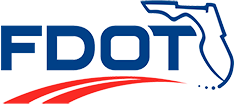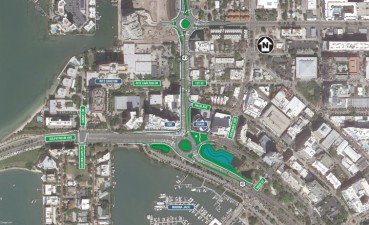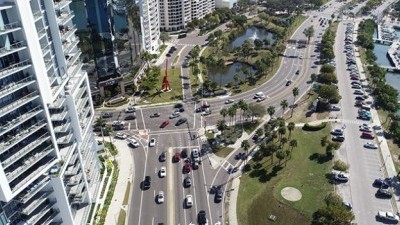438137-1 US 41 at Gulfstream Avenue Roundabout
Project Details
About
Project Description
The Florida Department of Transportation (FDOT) is reconstructing the signalized intersection on US 41 at Gulfstream Avenue and replacing it with a multi-lane roundabout. The primary goal of the US 41 improvements is to improve multi-modal mobility along the US 41 corridor, provide a safe, convenient and attractive crossing for pedestrians and bicyclists, and improve connectivity and circulation between the City of Sarasota’s Downtown Central Business District and the Bayfront area. Construction began March 2021.
Improvements consist of replacing the signalized intersection on US 41 at Gulfstream Avenue with a multi-lane roundabout that will enhance connectivity, circulation, and safety. Other improvements include installation of a Pedestrian Hybrid Beacon (PHB) signal system and raised pedestrian refuge islands, adding new sidewalks and pedestrian walkways, City of Sarasota utility, underground drainage structures and fiber optic replacements, new LED streetlights and reconfiguration of the stormwater retention ponds. Expected completion is fall 2022.
Project Overview
An aerial overview of the improvements being made at the intersection of US41 and Gulfstream Avenue.
US 41 at Gulfstream Avenue Roundabout Project
Benefits of Roundabouts
- Roundabouts have safe crossings for pedestrians and bicyclists. Slower speeds are generally safer for pedestrians.
- Roundabouts have fewer and less severe crashes and fewer injuries. Roundabouts keep people moving, but at speeds where injury risk is greatly reduced.
- More than 90% reduction in fatalities, 76% reduction in injuries and 36% reduction in all crashes.
- Roundabouts offer non-stop travel with no waiting at stop signs or traffic signals.
- Roundabouts accommodate more traffic than typical intersections.
- Roundabouts offer non-stop travel with no waiting at stop signs or traffic signals.
- Roundabouts eliminate the cost of traffic signals and signal maintenance. During power outages, traffic still flows freely.
- Businesses near roundabouts have seen an increase in sales with more customers who can easily and safely drive, walk, or bike there. They can also mark a business district or main street.
Project Improvements
- Replace signalized intersection on US 41 at Gulfstream Avenue with a multi-lane roundabout
- Install Pedestrian Hybrid Beacon (PHB) crossing signal system and raised pedestrian refuge islands
- Replace underground drainage structures, utilities, fiber optic, new LED streetlights and reconfigure stormwater retention ponds
- Construct new sidewalks and pedestrian walkways
PHB Beacon / Pedestrian Crossing
The Pedestrian Hybrid Beacon (PHB) is a high-intensity activated crosswalk beacon originally designed as a cost-effective option for crossings at mid-block and un-signalized intersections. Unlike conventional pedestrian signals, the Pedestrian Hybrid Beacon (PHB) is only operational when activated by a pedestrian. Relatively new, Pedestrian Hybrid Beacon (PHB) systems are being used with greater frequency for the additional safety they provide for pedestrians and for the versatility of use.
Below are a few highlights of the Pedestrian Hybrid Beacon (PHB) signal system that will be featured as part of the US 41 improvements.
- A Pedestrian Hybrid Beacon (PHB) is a High-Intensity Activated crosswalk beacon
- Primarily used for mid-block and un-signalized intersections
- Versatile application and use
- Cost-effective option for protected pedestrian crossing
- Signal has 3 lights in a triangular configuration: dual red lights above a single yellow light
- Signal stays at rest (in-active) until a pedestrian activates the signal by pressing a push-button
- Traffic flow is uninterrupted until signal is activated by pedestrian
- When the signal is activated, drivers are cautioned with a yellow flashing signal to prepare drivers to stop
- Drivers stop at the sustained red light
- Pedestrians cross during the alternating dual red flashing lights
- The signal goes dark when pedestrian movement is complete; drivers may continue forward
- Pedestrian Hybrid Beacon (PHB) works in conjunction with conventional pedestrian signal heads at each end of the crosswalk that indicate “Walk” and “Don’t Walk”
DOCUMENTS AND PUBLICATIONS
Project Newsletters
Temporary Pedestrian Route - A temporary route for pedestrians to use while in the construction phase.
Property Owner Notification - Project details and contact information.
FDOT welcomes and appreciates everyone's participation in the project. Meetings are developed in compliance with the Title VI of the Civil Rights act of 1964 and related statues. Public participation is solicited without regard to race, color, national origin, age, sex, religion, disability, or family status.
Information On Roundabouts
Benefits of a Roundabout - Factsheet on what a roundabout is and how it can help.
Roundabouts and First Responders - Brochure on how roundabouts can best help first responders.
Roundabouts and Pedestrians - Brochure on how pedestrians can approach a roundabout and stay safe.
Roundabout Safety [English] - English version of roundabout safety sheet.
Roundabout Safety [Spanish] - Spanish version of roundabout safety sheet.
Roundabouts entail many benefits when compared to traditional intersections. With the installation of not only current projects, but future ones as well, it is crucial to present not only the many positives of these roundabouts but to provide sound and accurate safety protocol for these newer instillations.
New Traffic Route Information
Temporary Traffic Movements - New traffic routes for phase IIB of construction.
Traffic Movement Video - Video depicting how traffic will move during this phase of the process.
While installation is underway, we ask the public to follow new routes established during the construction phase of the project. The new routes will run along the outskirts of the construction zone, which will occupy where the intersection was initially, which allows for the traversal of all routes beforehand.
Aerial Construction Progress Footage - A aerial view of the current state of the construction progress on the new roundabout.
Resource And Information Panels
Pedestrian Signals - Video showing how the new road signals will work and what to do when you see them.
All About Roundabouts - Informational video on roundabouts.
How To Navigate A Roundabout - Video showing how to enter, travel, and exit a roundabout.
Florida Roundabouts - Resource website on information about Florida's roundabouts.
Roundabouts are a newer concept for many people. This requires not only a well-tailored approach to presenting these ideas to the public, but also allowing this information to be easily accessible to anyone at anytime. These videos and websites allow for the public to be aware and involved in the coming instillations of new roundabouts now, and ones in the future.
MAP
An aerial view of the future of the project allowing better visualization of the final product.
Public Involvement
WEEKLY UPDATE SCHEDULE
RoadWatch Update for the Week of Sunday, July 2, 2023
In observance of the Independence Day holiday, the project contractor will not be working on Tuesday, July 4, 2023. Work will resume on Wednesday, July 5, 2023.
SARASOTA
US 41 at Gulfstream Avenue Roundabout Project, Sarasota: Construction project: Crews will work within the right-of-way, medians, driveways and throughout the project limits. Please use caution and watch for construction vehicles, dump trucks, semi-trucks and heavy equipment entering or exiting the work zone.
Activities Include:
- Restoration of select existing post mounted signs will take place. No impacts to traffic will occur.
Construction activities will take place weekdays and weekends, daytime and occasionally during nighttime hours. Expect noise from grinding asphalt, hammer drills, noise and vibration from construction equipment, backup alarms, vacuum trucks, pumps, and lighting.
Improvements being made as part of this project consist of replacing the existing signalized intersection on US 41 at Gulfstream Avenue with a roundabout, installation of Pedestrian Hybrid Beacon (PHB) system, raised pedestrian refuge islands, replacement of underground drainage structures, utilities, fiber optic, new LED streetlights, reconfiguration of stormwater retention ponds, sidewalks, and pedestrian walkways. Expected completion is spring 2023.
LANDSCAPING: Managed as a separate contract, the Gulfstream Roundabout Landscaping will begin in July when roadway construction and final acceptance are complete.
FAQs
Question: What is the difference between a roundabout and a traffic circle?
Answer: Traffic circles are much larger than a roundabout and often have stop signs or signals within the circular intersection. Roundabouts are smaller and vehicles must yield before entering. Roundabouts typically operate at relatively low speeds (<25 MPH) while traffic circles allow higher speeds (> 25 MPH). Roundabouts restrict pedestrians from entering the central island while some traffic circles allow pedestrians to cross to and from the central island.
Question: How do I drive in a multi-lane roundabout?
Answer: Reduce your speed to 10-15 mph as you approach the roundabout; follow signs and pavement markings to determine the lane(s) that will serve your destination; look left for oncoming traffic (traffic moves counter-clockwise); yield to vehicles already in the roundabout and wait for a gap to enter. Once you have entered, do not stop in the roundabout; do not pass other vehicles; use your turn signal to exit the roundabout to the right; yield to pedestrians crossing the exit lane and allow emergency vehicles to pass.
Question: How should drivers yield to emergency vehicles?
Answer: If you have not entered the roundabout, pull over to the right and allow the emergency vehicle to pass. If you have already entered the roundabout, continue to the closest exit, and pull over once you are beyond the splitter island to allow the emergency vehicle to pass. Never stop in a roundabout.
Question: Should I stop inside the roundabout to let someone in?
Answer: You should not stop after crossing the yield line and are in the roundabout circle. However, you may slow down so a safe gap becomes more obvious to the driver wanting to enter the roundabout.
Question: How are pedestrians accommodated in a roundabout?
Answer: Pedestrians use marked crosswalks between the splitter islands that separate the roundabout approach and exit lanes. The splitter island serves as a pedestrian refuge between the crosswalks and allows pedestrians to focus on crossing one direction of traffic at a time.
Question: What is a Pedestrian Hybrid Beacon (PHB) signal?
Answer: The Pedestrian Hybrid Beacon (PHB) crossing system is a high-intensity activated crosswalk beacon originally designed as a cost-effective option for protected pedestrian crossings at mid-block and un-signalized intersections. Unlike conventional pedestrian signals, the Pedestrian Hybrid Beacon (PHB) is only operational when activated by a pedestrian. The Pedestrian Hybrid Beacon (PHB) systems are being used with greater frequency for the additional safety they provide for pedestrians and for the versatility of use. We invite you to watch this informative video to learn more about the Pedestrian Hybrid Beacon (PHB). Watch the Pedestrian Hybrid Beacon (PHB) Video: Here
Question: What about visually impaired pedestrians?
Answer: Roundabouts are generally considered an advantage to the visually impaired because they can only cross one direction of traffic at a time and they can more easily distinguish between the vehicle noises. Also, the slower vehicle speeds at roundabouts make them generally safer for all pedestrians.
Question: How are bicyclists accommodated in a roundabout?
Answer: Bicyclists may share the roadway with vehicles or dismount and use the sidewalk and crosswalk system to navigate through the roundabout.
Question: How will large trucks be accommodated?
Answer: Roundabouts are designed to accommodate the turning movements of a tractor trailer rig. To accommodate the sweep of the trailer wheels as it makes its way through the roundabout, a truck apron is constructed around the inside of the circulating roadway. The apron is made of a different material or is colored differently to distinguish it from the circulating roadway and make it clear the truck apron is not intended to be driven on by smaller vehicles.
Question: Will I be able to access the businesses along US 41 at Gulfstream Avenue within the project limits during construction?
Answer: Yes, access to businesses will be maintained during construction. There are times that access may be limited to a single lane with flagging operations in place. The contractor will try to minimize these occurrences as much as possible and try to schedule operations at night/overnight.
Question: Will there be any lane closures during construction?
Answer: Yes, temporary lane closures may be in place at night/overnight between 7 p.m. and 6 a.m., and weekends at night/overnight between 9 p.m. and 6 a.m. The public will be notified in advance of lane closures through the media, the weekly RoadWatch Updates, or via Email Updates.
Question: Will construction take place at night?
Answer: Yes, the contractor is permitted to work during the daytime and occasionally during nighttime hours.
Question: Will there be any detours during construction?
Answer: Yes, there will be traffic detours in place only for night work. Road closure information will be communicated to the public at the appropriate construction phase.
Question: Will I be able to drive through the project limits during construction?
Answer: Yes, there will be both daytime and nighttime construction activities, but motorists will be able to navigate through the project limits.
Question: What will be the speed limit during construction?
Answer: During construction, the speed limit will be reduced to 25 mph on US 41 and Gulfstream Avenue. Speed limits may be adjusted throughout the project limits during construction. Once construction is complete, the speed limit will be 35 mph on US 41 and 25 mph within the roundabout.
Question: How long will construction last?
Answer: The estimated completion date is fall 2022, weather permitting.
Question: Who do I call if I have a question or concern about the project?
Answer: Contact our Community Outreach Team
Question: What are SBBS?
Answer: Shared Bus Bike Shoulders or SBBS are shoulders that allow buses/trolleys to share the space with bicycles/scooters under certain congested roadway conditions.
Question: Do bicyclists have to use the SBBS across the Ringling Bridge?
Answer: No, bicyclists may walk their bikes across the Ringling Bridge on the outside protected sidewalk.
Contact Information
| Communications Team |
|---|
|
Alice Ramos
863-797-7202
|
| For Media Inquiries Only |
|
fdot-d1comm@dot.state.fl.us
|



